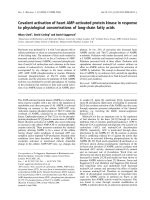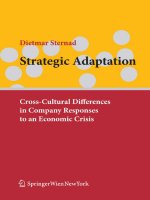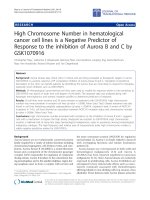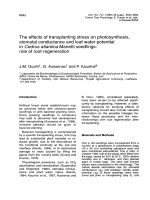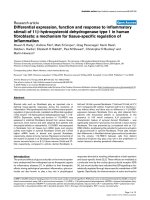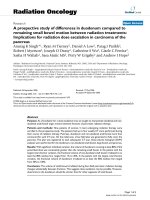Ethnic differences in cardiovascular response to stress role of trait anger, sex and migrant status
Bạn đang xem bản rút gọn của tài liệu. Xem và tải ngay bản đầy đủ của tài liệu tại đây (961.93 KB, 210 trang )
Ethnic differences in cardiovascular response to stress
1
CHAPTER 1
INTRODUCTION
________________________________________________________________________
The health research community is well aware of the impending global pandemic of
coronary heart disease (CHD) in developed countries as well as the increase in rates of
CHD in developing countries and economies in transition. Globalization and rapid
economic growth not only bring prosperity, but can also foster ill health with fast food, a
sedentary lifestyle and little relaxation (Chockalingam, 2000).
Over the past few decades the majority of research with regards to risk factors
associated with CHD has focused on risk associated with populations of Western
developed countries. Although many of the risk factors identified are also relevant for
non-Western populations, there is growing evidence that CHD incidence and mortality are
unevenly distributed within and across populations of both developed and developing
countries (Reddy &Yusuf, 1998).
Prevalence of Coronary Heart Disease
Epidemiological studies of international variations in CHD by specific ethnic
groups and geographic regions have been highlighted in a report on the global burden of
cardiovascular disease (Yusuf, Reddy, Ounpuu & Anand, 2001). Declining CHD death
Ethnic differences in cardiovascular response to stress
2
rates were found in most industrialized countries except in Eastern Europe and Russia
where the trends remained upwards. Among the Asian countries, CHD rates in Japan have
declined more rapidly than in the Western countries. By contrast, death rates from
cardiovascular disease and CHD in particular, have shown an increasing trend in China
(Woo & Donnan, 1989) and in India (Reddy & Yusuf, 1998). CHD rates in India are
expected to rise further with increase in life expectancy and per capita income (Reddy,
1993). Murray and Lopez (1996) found that of all deaths in 1990, 25% were attributable to
cardiovascular disease in India. Although, the relatively few mortality studies from India
make it difficult to present an accurate picture of disease prevalence in the country, there is
some evidence that CHD prevalence has markedly increased in urban India (Gupta &
Gupta, 1996).
Worldwide researchers have consistently found higher rates of CHD incidence and
mortality among individuals of South Asian origin. Sheth, Nair, Nargundkar, Anand, and
Yusuf (1999) investigated ethnic variations in major causes of death in Canada and
documented trends within ethnic groups of South Asians, Chinese and Europeans, for heart
disease. Rates of death from ischemic heart disease, expressed per 100,000 population,
were highest among the Canadians of South Asian origin (men 320.2, women 144.5)
followed by Canadians of European origin (men 319.6, women 109.9). Mortality rates
were lowest among Canadians of Chinese origin (men 107.0, women 40.0). Research done
Ethnic differences in cardiovascular response to stress
3
in the United Kingdom also points out that South Asians are at excess risk of CHD (Bhopal,
2000). In comparing South Asians and Europeans, electrocardiograph evidence has shown
a 37% excess of CHD in South Asians (McKeigue, Ferrie, Pierpoint, & Marmot, 1993;
Bhopal et al., 1999). To compare 10-year risk of CHD, stroke and combined CHD,
Cappuccio, Ookeshott, Strazzullo and Kerry (2002) applied the Framingham risk estimates
to ethnic minorities in UK. Among the ethnic groups of Whites, South Asians and Blacks,
people of African origin had the lowest 10-year risk estimate of CHD adjusted for age and
sex (7%). The Whites showed 8.8% risk estimate, while the South Asians showed the
highest estimated risk of 9.2%. The estimated risk of combined cardiovascular risk was
also highest in South Asians (12.5%) compared to 11.9% among Whites and 10.5% in
people of African origin.
Likewise, in the Asian context of Singapore, death rates for heart disease (22.1 %)
are second only to those for cancer (Ministry of Health, Singapore, 2006) with the three
major ethnic groups – Chinese, Malays and Indians showing variations in cardiovascular
disease incidence and mortality. In 1990, Hughes, Lun and Yeo found that Indians had
higher mortality from ischemic heart disease than the Chinese and Malays, with
age-standardized relative risk ratios of Indians vs. Chinese (males 3.8, females 3.4) and
Indian vs. Malays (males 1.9, females 1.6). For hypertensive disease Malays had highest
mortality, while few ethnic differences were found for cerebrovascular disease across the
Ethnic differences in cardiovascular response to stress
4
three ethnic groups. In yet another study of risk factors and incident of CHD in Chinese,
Malay, and Indian males, Lee et al. (2001) found Indians to be at greatest risk of CHD,
compared to Chinese (3.0; 2.0-4.8) and Malays (3.4; 1.9-3.3).
Emerging Factors of Ethnicity, Sex and Migrant populations
Ethnicity is emerging as an important demographic factor in heart disease
prevalence and mortality. In fact, the American Heart Association Taskforce on Strategic
Research Direction (S.C. Smith et al., 2001) identified ethnicity as one of the priority topics
in understanding why subgroups in a population experience CHD differently compared to
other populations in terms of prevalence of risk factors, risk-factor management, access to
care, lifestyle and metabolic risk factors, psycho-social risk factors, as well as genetic
variations (Roberts, Bonow, Loscalzo & Mosca, 2000).
Ethnicity is a construct that encompasses both genetic and cultural differences
(Anand, 1999). As individuals of different ethnic backgrounds tend to live in specific
regions, disparity in disease by ethnicity is a function of geographic differences, which in
turn reflect distinct lifestyles and socio-economic status. Such differences in rates of CHD
become apparent in studies across countries. For instance, the Seven Countries Study
(Menotti et al., 1993) found low CHD rates in Japan and Mediterranean countries as
compared to higher CHD rates in Finland and the United States (US). These differences
were largely attributed to differences in diet, serum cholesterol and blood pressure.
Ethnic differences in cardiovascular response to stress
5
However, this study did not look beyond traditional biological risk factors at other aspects
such as psychosocial variables to explain differences in rates of CHD. Such studies
highlight the need to examine ethnic differences associated with CHD in populations at risk
with a focus on underlying psychosocial variables.
Sex differences also exist in CHD. Women are more likely than men, to have
angina pectoris with normal coronary arteries, more likely to have poor outcomes after
bypass surgery, more likely to die after myocardial infarction and are influenced
differently by risk factors such as hypertension, diabetes, and inflammation (Maguire,
2003). CHD and stroke remain the leading killers of women in America and most
developed countries. Although it is estimated that one in two women will eventually die
of heart disease or stroke, until recently misperceptions still existed that CHD is not a real
problem for women (American Heart Association, 1997). In light of the paucity of
cardiovascular research among women, especially in the Asian context, there is a need to
examine differences in CHD between men and women.
Recent epidemiological findings have also clarified that, although CHD affects
women on an average of a decade later in life than men, this disease is the leading cause
of death in women just as in men. Despite their marked advantage in age-specific risk of
CHD death, the greater likelihood of survival of women to advanced ages produces nearly
equal numbers of actual deaths due to CHD in men and women. United States data from
Ethnic differences in cardiovascular response to stress
6
the National Center for Health Statistics (1997) shows that 39% more males than females
die from heart disease between the ages of 45 and 64. However, after the age of 65 years,
the death rate due to heart disease in women actually exceeds that in men by 22%. This
suggests that any protective effects of being female are largely gone by the age of 65.
Substantial ethnic differences in CHD deaths in women have also been documented
(Mosca et al., 1997). To the best of our knowledge, few studies have examined risk
factors related to coronary heart disease among women in an Asian context, let alone
looked at ethnic differences.
Migrant / minority populations have consistently been found to be at a higher
risk for CHD. Literature on health behaviors and disease indicates an increase in
behavioral risk factors (e.g. high fat diet, sedentary lifestyle) as well as biological risk
factors (e.g. obesity, hypertension) when individuals migrate to more prosperous
countries. There is also increasing evidence that socio-cultural and psychological factors
play a crucial role in an immigrant’s health across the world (Hovey & Magana, 2000).
As mentioned earlier, South Asian migrant populations (primarily Indians) have been
found to show high rates of CHD incidence in Europe (Phillimore, Beattie, & Townsend,
1994), USA (Goslar et al., 1997; Brown & James, 2000) and Canada (Sheth et al, 1999).
However, most of these studies drew no comparisons of these migrant Indian populations
with their counterparts in India.
Ethnic differences in cardiovascular response to stress
7
Extensive research thus points to the diversity in prevalence and mortality due to
coronary heart disease across countries and ethnic descent within a country, as well as sex.
More specifically, research findings indicate increased incidence of coronary heart
disease among people of South Asian origin. Indians in particular seem to be at increased
risk of CHD. However, most studies have looked at South Asians as a group including
people from India, Pakistan, and Bangladesh. It must also be noted that research that has
examined specific ethnic groups such as Indians, has been conducted among migrant
populations – whether in the West (Canada, United Kingdom) or in South-East Asia
(Singapore). This raises the question of whether it is ethnicity per se that explains
increased incidence and risk of CHD, a migrant/minority status, other psychosocial
factors, or perhaps a combination of ethnic, minority, and psychosocial factors that
provide the underlying explanation. We now continue with examining some of the
explanations that have been put forth to describe and understand ethnic differences in
coronary heart disease.
Factors Explaining Differences in Incidence of CHD
The possibilities of genetic determinism, inherent biological make-up, as well as
traditional factors emerging from lifestyle aspects of individuals from different ethnic
backgrounds, provide some explanations for increased cardiovascular risk for certain
ethnic groups. Researchers have long attributed cause of disease to an individual’s
Ethnic differences in cardiovascular response to stress
8
biological make up with traditional risk factors being presented as potentially critical
factors explaining differences in incidence and mortality due to CHD. However, such
factors including hypertension, obesity, cholesterol, parental history or cigarette smoking
account for less than 50% of CHD cases (Siegman, 1994). Research with regards to these
explanatory factors also suggests that rates of coronary heart disease may be explained in
part by differences across ethnicity, although underlying mechanisms remain unclear.
With increasing understanding that psychological and social processes play an
important role in linking behavior and health (T.W. Smith & Anderson, 1986), researchers
have identified psychosocial factors such as stress, anger, depression and social support,
to be related to CHD. Of these factors, anger / hostility has been found to be a critical
factor involved in CHD incidence and mortality (Abel, Larkin, & Edens, 1995) and is
also linked to other identified psychosocial factors. These psychosocial risk factors do not
occur in isolation, but tend to cluster in the same individuals and/or groups. For instance,
both men and women of lower socio-economic status are more likely to be depressed,
hostile, socially isolated and engaged in high-risk behaviors such as smoking and
drinking (Wamala, Mittleman, Schenck-Gustafsson, & Orth-Gomer, 1999) that contribute
to CHD risk (Anand et al., 2001).
One of the proposed mechanisms that may link psychosocial factors to CHD is
cardiovascular reactivity (CVR) – that is, psychosocial factors that lead to increased CVR
Ethnic differences in cardiovascular response to stress
9
are considered to be critical risk factors for CHD. Exaggerated cardiovascular responses to
stressors have been associated with increased risk of hypertension (Everson, Kaplan,
Goldberg, & Salonen, 1996), atherosclerosis (Barnett, Spence, Manuck, & Jennings, 1997),
and ischemia (Krantz et al., 1991). It is the interaction between psychosocial factors such as
anger / hostility and reactivity that the present study seeks to explore in an Asian
population, with emphasis on the Indian ethnic group (migrant and native), which evidence
suggests, is at most risk of developing CHD among the Asian populations.
Review of Literature
A brief review of some traditional risk factors that have been identified as crucial
for South Asians as a high-risk population is presented. We shall then scrutinize the
psychosocial factors that have been recognized as potential risk factors for CHD. In
particular, we shall examine anger / hostility in relation to CHD as well as its links to other
psychosocial factors, followed by a review of studies examining migratory status as a
possible factor involved in ethnic differences in CHD. Finally, an overview of research in
the area of cardiovascular reactivity, which has unmasked some pathways in which
psychosocial factors produce different patterns of cardiovascular reactivity across
ethnicity, sex and tasks, is presented.
Ethnic differences in cardiovascular response to stress
10
Traditional Risk Factors Related To Coronary Heart Disease
Classical risk factors for CHD such as smoking, blood pressure (BP), obesity and
cholesterol vary substantially across different ethnic groups and subgroups (Chaturvedi,
2003). Differences between European and non-European populations such as South Asians
and people of African descent have been examined previously (Liu et al., 1996). Among
established risk factors, R.Williams, Bhopal and Hunt (1994) found that South Asians in
the UK had less exposure only for smoking while there was a relative excess of other
known risk factors such as less exercise and more diabetes and central adiposity.
In Singapore, Indians are at a higher risk for heart disease with CHD rates among
Indian men aged 30 – 69 years being 3.8 times those for Chinese and 1.9 times those for
Malays (Hughes, Lun, & Yeo, 1990). However, these high rates remain unexplained by
traditional risk factors such as cigarette smoking, hypertension, or increased low-density
lipoprotein cholesterol (Hughes et al, 1997), which have been found to show no important
ethnic differences.
A prospective study, the Singapore Cardiovascular Cohort Study (Lee et al., 2001),
investigated the relationship between established coronary risk factors with incident CHD
for Chinese, Malay, and Indian males. Indians were found to have an increased risk of CHD
compared to the other ethnic groups. All the risk factors examined (hypertension, high
low-density lipoprotein cholesterol, smoking, diabetes, obesity) were found to play varying
Ethnic differences in cardiovascular response to stress
11
roles, with hypertension, diabetes and obesity emerging as the most important risk factors
among this Asian cohort. Research thus points to the fact that variations in CHD may in
fact be explained in some part by traditional risk factors but the exact relationships vary
across populations and ethnic groups. For instance, Hughes and colleagues found
non-insulin dependent diabetes mellitus (NIDDM) was highest among Indians, then
Malays and Chinese in Singapore (Hughes et al. (1990). Those with NIDDM also had
higher mean body mass indices, waist hip ratio and abdominal diameters, prevalence of
hypertension and higher levels of serum triglycerides (Hughes, Choo, Kuperan, Ong, &
Aw, 1998). Although the higher rates of CHD in Indians are partly explained by central
obesity, insulin resistance and metabolic syndrome (Hughes et al., 1997), these traditional
risk factors have not been able to fully explain ethnic and sex differences in incidence and
progression of CHD.
We continue with examining some of the other explanations that have been put
forth to describe and understand differences in CHD across ethnicity and sex. To arrive at
specific research questions for investigating the roles of ethnicity and sex in explaining risk
and incidence of CHD among Indians, the focus here lies on anger / hostility and migratory
status as psychosocial risk factors modified by ethnicity and sex, their relationship to
cardiovascular reactivity, and therefore, to CHD.
Ethnic differences in cardiovascular response to stress
12
Psychosocial Risk Related to Coronary Heart Disease
Ethnic variations in CHD may reflect the unique personal and historical
experiences as well as the current social conditions of ethnic groups. The health behaviors
and other risk factors for CHD should therefore be understood within the personal and
social contexts that facilitate their initiation and maintenance (D.R.Williams & Rucker,
1996). Some researchers have thus looked at psychosocial factors that have been linked to
CHD as possible explanations for ethnic differences in the disease. Similarly, how these
psychosocial factors affect men and women and therefore their cardiovascular health may
be different. This highlights the need to look at both ethnic and sex differences as related to
psychosocial risk for CHD.
An expanding literature has documented associations between several
psychosocial factors and increased incidence of CHD. The most prominent of the
identified factors include anger/hostility, psychological stress, depression and the lack of
social support (Krantz & McCeney, 2002). All of these have been associated with clinical
outcomes in CHD patients through mechanisms that involve physiological pathways as
well as possible failure to adopt a healthy lifestyle. These factors have also been found to
have a close relationship with anger / hostility and are therefore briefly discussed here.
Psychological stress has been implicated in the etiology of CHD, both with
laboratory/experimental stressors as well as in real life/everyday stress situations.
Ethnic differences in cardiovascular response to stress
13
Exaggerated cardiovascular reactions to acute stress have been implicated in both the
development and expression of cardiovascular disease (Schwartz et al., 2003; Lepore,
Miles & Levy, 1997). Mental stress has been found to predict future blood pressure and
hypertension in a study that recorded blood pressure at initial screening and during a
mental stress task (Carroll et al., 2001). Examination of blood pressure status ten years
later showed that both systolic blood pressure (SBP) and diastolic blood pressure (DBP)
reactions to stress were predictive of hypertension at follow-up. This suggests that
heightened blood pressure reactions to mental stress may contribute to the development of
hypertension. There is also emerging evidence that acute stress reactivity as examined in
laboratory settings may not be independent of stressful life experiences (Carroll, Philips,
Ring, Der, & Hunt, 2005). Individuals exposed to high impact life events may be less
likely to engage with the minor challenges of acute stress tasks, or the mere exposure to
stressful life events may desensitize the hemodynamic system of an individual, thus
resulting in diminished reactivity.
Depression has also been identified as a frequent precursor of CHD and may
impede recovery as well (Booth-Kewley & Friedman, 1987; Frasure-Smith, Lesperance,
& Talajic, 1993; 1995; Lesperance, Frasure-Smith, Juneau, & Theroux, 2000). There is
consistent evidence that depression affects organic disease processes and subsequent
morbidity and mortality among individuals having cardiovascular disease (Krantz &
Ethnic differences in cardiovascular response to stress
14
McCeney, 2002). Behavioral and physiological mechanisms associating depression and
cardiovascular disease suggest that depressed individuals are likely to indulge in
risk-related behaviors such as smoking or lack of physical activity (Carney, Freedland,
Rich, & Jaffe, 1995). However, after controlling for such traditional risk factors and
related behaviors, depression remains associated with poor cardiac outcomes (Glassman
& Shapiro, 1998).
Social support has been consistently linked to health outcomes and lack of social
support has emerged as a risk factor of considerable magnitude, not only for CHD, but
also morbidity and mortality from all causes (Allan & Scheidt, 1996). Prospective studies
have confirmed the association between low social support and risk of CHD (Kawachi,
Sparrow, Spiro, Vokonas, & Weiss, 1996) and indicated an important role of low social
support in mortality from pre-existing disease (Case, Moss, Case, McDermott & Eberly,
1992; R.B.Williams et al., 1992). In fact, both quantity and quality of social support may
be important predictors of health (Orth-Gomer, Rosengren, & Wilhelmsen, 1993; Krantz
& McCeney, 2002).
Anger / hostility has often been implicated as predisposing factors in coronary
heart disease as well as hypertension (Everson et al., 1997). Increasingly well designed
prospective studies as well as quantitative reviews have found this association to hold true.
High levels of a tendency to experience anger have been found to be positively related to
Ethnic differences in cardiovascular response to stress
15
resting blood pressure and development of hypertension (Jorgensen, Johnson, Kolodziej,
& Schreer, 1995; Suls, Wan & Costa, 1995). Previously a quantitative review came to the
conclusion that anger / hostility and related behaviors are associated with an increase in
CHD risk and premature mortality (Miller, Smith, Turner, Guijarro & Hallet, 1996) and
later prospective studies confirm such associations (Chang, Ford, Meoni, Wang, & Klag,
2002; Gallacher, Yarnell, Sweetnam, Elwood, & Stansfeld, 1999). In addition there is
growing evidence that anger and hostility are associated with psychological distress
(Kopper & Epperson, 1996), lower levels of social support (Houston & Vavak, 1991), and
depression (G.A. Kaplan, 1995).
Clustering of Psychosocial Risk Factors
One significant development in research findings has been the realization that a
person’s risk of developing CHD rarely depends on a single factor; in most cases risk is
determined by a synergy between two or more risk factors, thus magnifying their effect
on CHD risk (R.B.Williams, 1999; R.B.Williams, Barefoot, & Schneiderman, 2003).
Psychosocial factors such as anger, hostility, stress, depression, anxiety and social support
do not occur in isolation, but tend to cluster in the same individuals and groups.
Benotsch, Christensen and McKelvey (1997) have shown that individuals with high levels
of anger / hostility also show greater levels of interpersonal stress in their daily lives, less
social support, and higher mean SBP. Similarly, R.B.Williams et al. (1997) identified
Ethnic differences in cardiovascular response to stress
16
potential mediators of job strain effects on health among working women, reporting
increased levels of negative emotions like anxiety, anger, depression and hostility, as well
as reduced levels of social support. Such findings clearly indicate that the
health-damaging psychosocial factors considered, tend to cluster in certain individuals,
and when such psychosocial factors do co-occur, their impact on mortality is further
compounded.
Contrada (1994) points out that the relationship between anger and stress can be
explained through the three components of exposure, problem representation, and
response generation. Exposure refers to the fact that individuals high in trait anger also
report frequent episodes of experiencing anger and respond with anger to a wider range of
provocations (Deffenbacher, 1992). As an individual shapes his or her own environment,
anger prone individuals are likely to find themselves in more stressful situations and then
react with greater anger to such situations. In terms of problem representation, people
high in anger tend to appraise situations as threatening and thus experience escalating
levels of frustration and antagonism. Finally, in responding to stressful situations, anger
prone people frequently let out their frustrations through physical or verbal expression of
their anger.
Expressing anger in a frustrating, uncontrolled manner is likely to lead other
persons to believe that these anger prone individuals are less likeable people to be around
Ethnic differences in cardiovascular response to stress
17
during social interactions. This undermines an angry or hostile individual’s potential
sources of social support as friends and acquaintances tend to avoid them. Such
individuals also avoid seeking or accepting social support and may thus perceive
themselves as having less social support during a stressful situation. Individuals
displaying high levels of hostility, as reflected through cynical mistrust, and with a
tendency of suppressing their anger, have been found to report receiving less family
support and having less trusting relationships (Greenglass, 1996). Such social isolation is
also likely to lead to feelings of rejection, loneliness and depression. Thus we find that
not only is anger / hostility directly related to CHD but is also likely to play a role in the
effects of other psychosocial factors linked to cardiovascular disorders.
Social support is also affected by anger / hostility among individuals when
examined in relation to health behaviors. Although hostility and social support have
typically been examined as separate factors related to CHD, some findings suggest that
when considered in combination they account for cardiovascular outcomes above and
beyond their separate main effects (Knox et al., 2000). Complex interactions in the effects
of anger / hostility and social support have also been well demonstrated in a study by
Brownley, Light and Anderson (1996). The effects of hostility and social support on clinic,
work and home SBP and DBP were evaluated in African American and Caucasian
American men and women. Importantly among the high hostile participants, across
Ethnic differences in cardiovascular response to stress
18
ethnicity and sex, high appraisal of social support was related to lower overall BP while
no buffering effect was evident among the low hostile individuals.
Raynor, Pogue-Geile, Kamark, McCaffery and Manuck (2002) argue that
depression, hostility and social support should be interrelated, as depressed persons may
view the world in a cynically hostile manner. A hostile individual may be less likely to
perceive social support or may drive away sources of social support, thereby increasing
risk of depression. Brummett et al. (1998) found that social support was independently
and negatively associated with depression, and hostility predicted depression, by way of
its negative relation with social support. These results are just one example of the
complex effects of social support in the presence versus absence of hostility with regards
to CHD related health behaviors.
To sum up, anger / hostility emerges as an important psychosocial risk factor
related to CHD, not only as an independent factor but also related strongly to other
psychosocial factors that have been found to show negative effects on cardiovascular
health. The present study focuses on anger as an underlying risk factor to examine its
contribution to CHD related risk.
Anger / Hostility
The deleterious effects of anger / hostility on cardiovascular health are
increasingly gaining attention in the research literature with evidence for an anger-CHD
Ethnic differences in cardiovascular response to stress
19
association derived from studies using different measures of anger and different CHD end
points. Hostility is generally referred to as a multifaceted cognitive phenomenon
(Spielberger, Jacobs, Russell, & Crane, 1983) consisting of negative beliefs about others
and an endorsement of statements that other people are untrustworthy, undeserving, or
even immoral (Barefoot, 1992). It thus carries a negative connotation of attitudes such as
cynicism, mistrust and suspicion. These beliefs may produce attribution biases that make
it more likely for the behaviors of others to be interpreted as antagonistic or threatening.
Anger on the other hand, refers to an affect experienced by an individual facing
frustration or irritation. The experience of anger varies in intensity from mild irritation or
annoyance, to fury and rage, (Speilberger et al., 1983) and is usually accompanied by
physiological arousal, characteristic facial expressions and activation of action tendencies.
Anger can be experienced as a situationally determined transient emotional state (T.W.
Smith, 1994), or as an enduring trait predisposing an individual to experience frequent
and pronounced episodes of anger across a number of situations.
Studies have shown that hostility as measured by the Cook and Medley Hostility
Scale (Cook & Medley, 1954) is moderately correlated with some measures of anger
(Bishop & Quah, 1998; T.W. & Frohm, 1985). High hostile individuals also tend to
experience excessive anger over a wide variety of situations (T.W. Smith, Pope, Sanders,
Allred, & O’Keeffe, 1988) and such anger arousals tend to be high in terms of frequency,
Ethnic differences in cardiovascular response to stress
20
intensity and duration. Hence, hostility and anger appear to share a common denominator,
with hostility reflecting negative worldviews and beliefs about other people, and anger
arousal forming the means of translating such beliefs and outlooks into affective and/or
behavioral responses. Hostility can thus be seen as an underlying attribute in the
expression and experience of anger. As such, it becomes difficult to operationally tease
out these two concepts, even though they remain conceptually distinct (Miller, Smith,
Turner, Guijarro, & Hallet, 1996). For the present study we are focusing on anger as the
presumed pathway by which hostility exerts its effect.
A number of prospective studies have consistently demonstrated the relation
between anger / hostility and risk for major coronary events and mortality (T.W. Smith,
1992; Miller et al., 1996) whether taken as a personality characteristic (a trait) or as an
episode (a state). It has been suggested that persons with high trait anger, merely with their
propensity towards anger and longer exposure to its physiological effects might be more
susceptible to CHD (J. E. Williams et al., 2000) as intense anger has been associated with
increased risk of acute myocardial infarction (Mittleman et al., 1995) and angina pectoris
(Kawachi et al., 1996) as well as progression of coronary arthrosclerosis (Angerer et al.,
2000).
Chang et al. (2002) performed a prospective study of 1055 men followed up for 32
to 48 years to examine the risk of premature and total cardiovascular disease associated
Ethnic differences in cardiovascular response to stress
21
with anger responses to stress during early adult life. During a median follow-up of 36
years, 205 men developed cardiovascular disease, 77 of whom developed premature
disease (defined as events before 55 years of age). Information on reactions to stress was
obtained through self reports on the Habits of Nervous Tension Questionnaire (Thomas,
1977 as cited in Chang et al., 2002). The highest level of anger (defined as self report of all
3 possible reactions to stress – expressed or concealed anger, gripe sessions, and
irritability) was associated with an increased risk of premature CHD (relative risk, 3.5; 95%
CI, 1.1-11.8) and premature myocardial infarction (relative risk, 6.4; 95% CI, 1.8 - 22.3)
compared to lower levels of anger. Evidence also suggests that hostility is more highly
associated with cardiovascular outcomes in younger individuals (Miller et al., 1996).
In Kawachi et al.’s (1996) study, 1303 men who were free of diagnosed coronary
disease completed a trait anger questionnaire (MMPI-2 derived Anger Content scale).
After a 7-year follow-up, there were 50 cases of documented CHD and 60 cases of angina
pectoris. Compared to men with low anger content scores, the adjusted relative risk among
men with high scores on this trait-anger scale was 3.15 for documented CHD and 2.66 for
all coronary events including angina pectoris.
A meta-analysis of studies has shown that this association between anger and
coronary disease remains significant when other risk factors are statistically controlled
(Miller, et al., 1996) and is at least as strong as the relationship between coronary disease
Ethnic differences in cardiovascular response to stress
22
and traditional risk factors such as smoking and cholesterol (T.W. Smith, 1992). In fact,
Everson et al. (1997) found that the association between anger / hostility and an increased
risk of a coronary event was mediated through other behavioral factors – suggesting that
individuals high on anger / hostility might have a psychological profile that makes them
more vulnerable to coronary disease. Mittleman et al. (1995) found that intense episodes of
anger expressed outwardly served as significant triggers for acute myocardial infarctions.
Compared to a control period, the relative risk for experiencing such an event in two hours
following an episode of intense anger was 2.3.
Mechanism Linking Psychosocial Risk Factors to CHD
Despite the evidence linking psychosocial factors to CHD risk, mechanisms
underlying this association still remain to be fully understood. Two sets of pathways have
been proposed. One is the behavioral pathway, whereby health behaviors such as smoking,
diet, physical activity or alcohol consumption are influenced by psychosocial factors which
in turn modify CHD risk (Stansfeld & Marmot, 2002). The second is the
psychophysiological pathway and involves more direct effects on the biological functions
relevant to CHD.
The dynamic associations between psychological factors and biological responses
represent the psycho-physiological processes. These processes are defined as the
pathways through which psychosocial factors influence physiological systems via the
Ethnic differences in cardiovascular response to stress
23
central nervous system activation of autonomic, neuroendocrine, and immunological
responses (Steptoe & Brydon, 2005). Research in this area has greatly contributed to the
understanding of possible ways in which psychosocial factors increase risk of CHD
and/or trigger cardiac events in people with diagnosed CHD, although the strongest
evidence in its favor still comes from animal studies (Kaplan & Manuck, 1999; McCabe
et al., 2000). In proposing some potential avenues for research, R.B. Williams (1994)
suggested that the impact of correlates of hostility such as high cholesterol and increased
catecholamines reactivity on macrophage activation could accelerate atherogenesis.
Furthermore, the biobehavioral characteristics of hostile individuals could in fact be due
to diminished brain serotonin function; thus making anger / hostility a pathogenic factor
for CHD.
In understanding the link between psychosocial factors and coronary disease, stress
emerges as a crucial factor to be examined. It is known to produce hemodynamic,
endocrine, and/or immunological changes that plausibly effect the development or
progression of heart disease in human beings. Hemodynamic and neuroendocrine
responses to stress are typically characterized by release of catecholamines and
corticosteroids, increases in heart rate, cardiac output, and blood pressure (Krantz &
Manuck, 1984) as well as changes in processes relevant to clotting, such as coronary
vasoconstriction, platelet aggregation, or plaque rupture (Patterson, Krantz, & Jochum,
Ethnic differences in cardiovascular response to stress
24
1995). In exploring the effect of stress on CHD it is also important to note and clarify the
distinction between chronic and acute risk factors. Krantz and McCeney (2002) point out
that chronic risk factors refers to factors that exert their influence over long periods of time
such as smoking, elevated levels of cholesterol, hypertension, and so on. An acute risk
factor, on the other hand, is a transient pathophysiologic change that is a result of exposure
to external physical or psychological factors. The primary concern here is with regards to
psychosocial effects of acute stress and anger.
Two aspects of physiological responses elicited in an individual – reactivity
(magnitude of change elicited) and recovery (time taken to reach initial levels of response
before change was elicited) have been linked to CHD related risk. For most physiological
indicators, high reactivity and delayed recovery are considered pathogenic and suggestive
of dysfunction in the physiological regulatory processes (Steptoe, 1998). Cardiovascular
reactivity is defined as changes in physiological parameters (such as heart rate, blood
pressure, etc.) in response to behavioral or psychological stressors or challenges (Krantz
& Manuck, 1984). It is suggested in many current psychosomatic models that repeated,
severe and/or prolonged episodes of stress related CVR contribute to the development of
CHD (T.W. Smith & Christensen, 1992) when occurring in combination with other
psychosocial factors.
One proposed pathway suggests that cardiovascular reactivity is a stable
Ethnic differences in cardiovascular response to stress
25
individual difference variable. The reactivity hypothesis states that certain individuals are
dispositionally high reactors to stressful situations and such exaggerated responses have a
harmful effect on the cardiovascular system, which increases risk of subsequent CHD
(Christenfeld, Glynn, Kulik, & Gerin, 1998), while others being low reactors remain at a
lower risk of developing heart disease. A complementary hypothesis in the cardiovascular
reactivity-CHD link presents cardiovascular reactivity as a possible mediating variable
between psychosocial risk factors and heart disease (Anderson & Lawler, 1995).
Cardiovascular reactivity in relation to CHD has been investigated using both of
the above-mentioned pathways. Some studies have examined the hypothesis suggesting
that CVR is an individual difference variable. For instance, Light, Sherwood & Turner
(1992) studied a sample of 51 men from 1988 to 1989 who had participated in an earlier
study conducted between 1974 and 1978. At this 10 to 15 year follow-up, high reactivity
for a reaction time task predicted higher blood pressure (BP) and heart rate (HR) levels.
Reactivity predicting higher resting BP shows a relationship between hyper-reactivity
under stress and higher resting BP levels that increase the likelihood of developing
hypertension, which is an established risk factor for heart disease. The Kuopio Ischemic
Heart Disease study of Eastern Finnish men, also demonstrated that a hyper-reactive
cardiovascular response is predictive of increased CHD risk (Kamarck et al., 1997).
From an initial sample of 2682 men (1984-1989), 1038 volunteered for a follow-up

